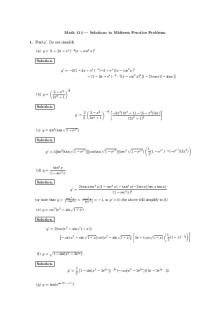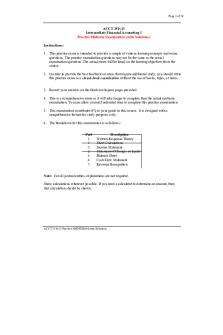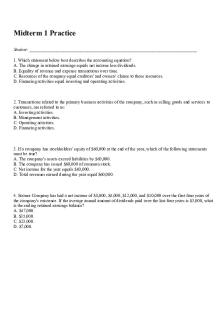Midterm 1 practice test and solutions PDF

| Title | Midterm 1 practice test and solutions |
|---|---|
| Author | Pat Keating |
| Course | Simulation |
| Institution | Georgia Institute of Technology |
| Pages | 7 |
| File Size | 121.2 KB |
| File Type | |
| Total Downloads | 24 |
| Total Views | 153 |
Summary
Midterm 1 practice test and solutions from previous year...
Description
1 NAME →
ISyE 6739 — Test 1 Solutions — Summer 2015 This test is 100 minutes long. You are allowed one cheat sheet. 1. (50 points) Short-Answer Questions (a) What is any subset of the sample space called? Solution: Event.
✷
(b) If P(A) = 0.35 and P(B) = 0.45, and A and B are disjoint, find P(A ∩ B). Solution: 0.
✷
(c) If P(A) = 0.35 and P(B) = 0.45, and A and B are disjoint, find P(A ∪ B). Solution: P(A) + P(B) = 0.8.
✷
(d) If P(A) = 0.7 and P(B) = 0.5, and A and B are independent, find P(A ∩ B). Solution: P(A)P(B) = 0.35.
✷
(e) If P(A) = 0.7 and P(B) = 0.5, and A and B are independent, find P(A ∪ B). Solution: P(A) + P(B) − P(A ∩ B) = P(A) + P(B ) − P(A)P(B ) = 0.85. ¯ = A ∩ B. (f) TRUE or FALSE? A¯ ∪ B Solution: TRUE — this is DeMorgan’s Law. (g) TRUE or FALSE? If n ≥ r ≥ 0, then Solution: TRUE.
✷
n r
✷
= Pn,r /r!.
✷
2 (h) Calculate Solution:
5 2
.
5! 2! 3!
= 10.
✷
(i) Calculate P9,4 . Solution: 9!/5! = 3024. (j) TRUE or FALSE? Solution: TRUE.
✷
Pn n i=0
i
= 2n for any n ≥ 0.
✷
(k) TRUE or FALSE? If A and B are disjoint, then they are independent. Solution: FALSE.
✷
(l) TRUE or FALSE? The events A and A¯ always form a partition. Solution: TRUE.
✷
(m) TRUE or FALSE? If A and B are independent, then P(A|B) = P(A∩B)/P(A). Solution: FALSE.
✷
(n) How many ways can you arrange the letters in “MISSPELLING”? Solution: 11!/(2! 2! 2!) = 4989600.
✷
(o) If I told you to “Pay attention to your posterior”, which important theorem would I be talking about? Solution: Bayes Theorem (which deals with posterior probabilities). (p) TRUE or FALSE? P(A ∪ B ∪ C) ≤ P(A) + P(B ) + P(C). Solution: TRUE — Just look at a Venn diagram.
✷
✷
3 (q) Who is the best stats teacher ever in the entire universe? Solution: So easy, I won’t even bother writing the answer.
✷
2. (10 points) A box contains 3 red sox and 2 yellows. Two sox are selected randomly without replacement. (a) What is this experiment’s sample space? Solution: {RR, RY, Y R, Y Y }.
✷
(b) Suppose X denotes the number of yellow sox selected. What are the possible values of X ? Solution: X = 0, 1, 2.
✷
(c) Calculate the probability that X = 1. Solution: P(RY ) + P(Y R) =
3 5
· 42 + 52 ·
3 4
= 0.6.
✷
3. (10 points) Everybody in Buffoonalo, NY participates in at least one of the following sports: bowling, skiing, and aerobics. In particular, 60% of the people bowl, 60% ski, and 50% do aerobics; 40% bowl and ski; 20% bowl and do aerobics; and 30% ski and do aerobics. (a) What proportion of the people bowl or ski? Solution: P(B ∪ S) = P(B) + P(S) − P(B ∩ S) = 0.6 + 0.6 − 0.4 = 0.8.
✷
(b) What proportion of the people participate in all three sports? Solution: Since everyone in Buffoonalo does something, we have 1 = P(B ∪ S ∪ A) = P(B) + P(S) + P(A) − P(B ∩ S) − P(B ∩ A) − P(S ∩ A) + P(B ∩ S ∩ A) = 0.6 + 0.6 + 0.5 − 0.4 − 0.2 − 0.3 + P(B ∩ S ∩ A),
4 so that P(B ∩ S ∩ A) = 0.2.
✷
(c) What proportion only do aerobics (and nothing else)? ¯ ∩ S¯ ∩ A) = 0.2 via a careful Venn diagram (as Solution: You can find P(B we’ve done in class). ✷
4. (10 points) An electronic assembly consists of two subsystems, say A and B. Suppose we have the following information: • P(B fails) = 0.6
• P(A and B fail) = 0.3
• P(A fails but B doesn’t fail) = 0.1
Find the probability that B fails given that A fails. Solution: By the law of total probability, P(A fails) = P(A and B fail) + P(A fails and B doesn’t fail) = 0.4. Therefore, P(B fails | A fails) =
P(A and B fail) = 3/4. ✷ P(A fails)
5. (10 points) Pick 7 cards from a standard deck. Find the probability of getting exactly three pairs and one junk card. Solution: Number of ways to pick 3 pairs = 13 . 3 Number of ways to pick suits for 3 pairs = Number of ways to junk card = 40. Thus, the desired probability is 134 3 3
522 7
40
43 2
.
≈ 0.0185. ✷
5 6. (10 points) There are 6 married couples are in a room. Suppose that we randomly pair up each of the men with one of the women (for conversation purposes only). (a) How many possible pairings are there? Solution: 36.
✷
Actually, if you interpreted the question to mean how many sets of pairings are there, I guess I could accept 6! = 720. ✷ (b) What is the probability that every husband and wife will be matched correctly? Solution: 1/6! = 1/720.
✷
(c) What is the probability that at least one of the pairs will be an actual husband–wife pair? Solution: This is essentially an envelope problem with n = 6. Therefore, the desired probability is 1−
1 1 1 1 1 91 1 = 0.6319 ≈ 1 − . ✷ + − + − = e 2! 3! 4! 5! 6! 144
7. (50 points) Still More Short-Answer Questions. . . (a) What does the “m” in “p.m.f.” mean? Solution: mass.
✷
(b) Suppose X has p.d.f. f (x) = x3 , 0 ≤ x ≤ c. Find c. Solution:
Rc 0
f (x) dx = 1 implies c = 41/4 =
√
2 = 1.414.
✷
(c) Suppose that X is discrete with f (−2) = 0.2, f (0) = 0.5, and f (4) = 0.3. Find F (1.2), where F (x) is the c.d.f. of X . Solution: F (1.2) = P(X ≤ 1.2) = f (−2) + f (0) = 0.7.
✷
6 (d) Suppose X has p.d.f. f (x) = 2x, 0 ≤ x ≤ 1. Find P(3/4 ≤ X ≤ 2). Solution: P(3/4 ≤ X ≤ 2) = P(3/4 ≤ X ≤ 1) =
R1
3/4
2x dx = 7/16.
✷
(e) Suppose X has p.d.f. f (x) = 2x, 0 ≤ x ≤ 1. Find P(0 ≤ X ≤ 1/2 | 1/4 ≤ X ≤ 3/4). Solution: P(0 ≤ X ≤ 1/2 ∩ 1/4 ≤ X ≤ 3/4) P(1/4 ≤ X ≤ 3/4) P(1/4 ≤ X ≤ 1/2) = P(1/4 ≤ X ≤ 3/4) R 1/2 f (x) dx 1/4 = R 3/4 f (x) dx 1/4
P(0 ≤ X ≤ 1/2 | 1/4 ≤ X ≤ 3/4) =
= 3/8. ✷ (f) If f (y) = 2y, 0 < y < 1, find E[Y ]. Solution:
R1 0
yf (y) dy = 2/3.
✷
(g) If f (y) = 2y, 0 < y < 1, find E[1/Y 2 ]. Solution:
R1 0
(1/y 2 )f (y) dy = ∞. (Oops! Didn’t mean to trick you!)
✷
(h) If E[X] = 3 and E[X 2 ] = 10, find Var(X). Solution: E[X 2 ] − (E[X])2 = 1.
✷
(i) TRUE or FALSE? Var(X) ≥ 0 for any random variable X . Solution: Let µ = E[X]. Then, by definition, Var(X) = E[(X − µ)2 ]. This is the expected value of something that cannot be negative. Therefore, the answer is TRUE. ✷
7 (j) If E[X] = 3 and Var(X) = 7, find E[−2X − 5]. Solution: E[−2X − 5] = −2E[X] − 5 = −11.
✷
(k) If E[X] = 3 and Var(X) = 7, find Var(−2X − 5). Solution: Var(2X − 3) = 4Var(X) = 28.
✷
(l) If P(X = 0) = 0.4 and P(X = 1) = 0.6, name the distribution of X (including any parameter(s)). Solution: Bernoulli(0.6).
✷
(m) If P(X = 0) = 0.4 and P(X = 1) = 0.6, find E[ℓn(X + 1)]. Solution: By LOTUS, ℓn(2) · 0.6 = 0.4159. ✷
P
x
ℓn(x + 1)f (x) = ℓn(1)f (0) + ℓn(2)f (1) =
(n) What result says that P(|X − E[X ]| ≥ 1) ≤ Var(X)? for any random variable X? Solution: Chebychev’s inequality (with ǫ = 1).
✷
(o) Suppose that the probability that GT wins any football game in 0.7, and that all games are (somehow) independent. What is the probability that GT will win exactly 3 out of its next 4 games? Solution: Let the number of games won ∼ Binomial(4, 0.7). Then 4 X be 3 P(X = 3) = 3 (0.7) (0.3)1 = 0.4116. ✷ (p) Consider a lightbulb whose lifetime is exponential with a mean of 1 year. What’s the probability that the bulb will live at least two years before failing? Solution: Let X be the lifetime ∼ Exp(1). Then P(X > 2) = e−2 = 0.1353. ✷
R∞ 2
e−x dx =...
Similar Free PDFs

Midterm Practice 1 Solutions
- 9 Pages

Practice Test 1 - Solutions
- 21 Pages

Practice Midterm 2 - Solutions
- 5 Pages

Practice Midterm Solutions
- 20 Pages

Practice Test 2 - Solutions
- 22 Pages

2017 Midterm answers - practice test
- 10 Pages

Midterm 1 A solutions
- 10 Pages

Practice midterm 1 2021s
- 14 Pages

CSE114 Practice Midterm 1
- 12 Pages

practice test 1 and 2
- 19 Pages

Midterm 1 Practice
- 19 Pages

Midterm 1 Practice
- 12 Pages
Popular Institutions
- Tinajero National High School - Annex
- Politeknik Caltex Riau
- Yokohama City University
- SGT University
- University of Al-Qadisiyah
- Divine Word College of Vigan
- Techniek College Rotterdam
- Universidade de Santiago
- Universiti Teknologi MARA Cawangan Johor Kampus Pasir Gudang
- Poltekkes Kemenkes Yogyakarta
- Baguio City National High School
- Colegio san marcos
- preparatoria uno
- Centro de Bachillerato Tecnológico Industrial y de Servicios No. 107
- Dalian Maritime University
- Quang Trung Secondary School
- Colegio Tecnológico en Informática
- Corporación Regional de Educación Superior
- Grupo CEDVA
- Dar Al Uloom University
- Centro de Estudios Preuniversitarios de la Universidad Nacional de Ingeniería
- 上智大学
- Aakash International School, Nuna Majara
- San Felipe Neri Catholic School
- Kang Chiao International School - New Taipei City
- Misamis Occidental National High School
- Institución Educativa Escuela Normal Juan Ladrilleros
- Kolehiyo ng Pantukan
- Batanes State College
- Instituto Continental
- Sekolah Menengah Kejuruan Kesehatan Kaltara (Tarakan)
- Colegio de La Inmaculada Concepcion - Cebu



